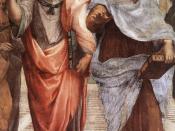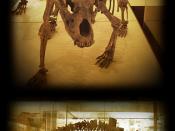Plato's cave allegory is an analogy of an individual's journey from ignorance to enlightenment, as well as referring to his beliefs of the world of appearances, and the world of Reality.
The individuals are chained within the cave by their legs and necks meaning they cant escape or move their heads, rendering them prisoners. The cave is dark, and there is a long, steep upward tunnel leading outside. Their only source of light within that cave are the flames that are above and behind them, emitting an erratic light by which they see things. As light represents knowledge and truth, the flames represent a contrived knowledge source - what they see and know is in fact not real, but actually something someone wants them to believe. Behind the prisoners is a low wall that the puppeteers parade statues, figures and various other vessels shaped from stone and wood from behind, going by on a type of track.
To accompany the figures, the puppeteers make noises and voices, causing echoes to go with the shadows - this links into the deception the prisoners are experiencing because they can only hear what people want them to hear.
The prisoners eventually are able to guess which figure comes next, however Plato argues that this is not, however philosophy, but just means that the prisoners have acquired the skill to become good at guesswork.
Plato then goes on to suggest what would happen if one of the captives were to be liberated from his chains, and attempt to stand up and leave the cave. He would be filled with pain at first from the chains, and the steep upward journey out of the cave. The light from outside would also temporarily blind and confuse him. At first, the former prisoner would want to go...


